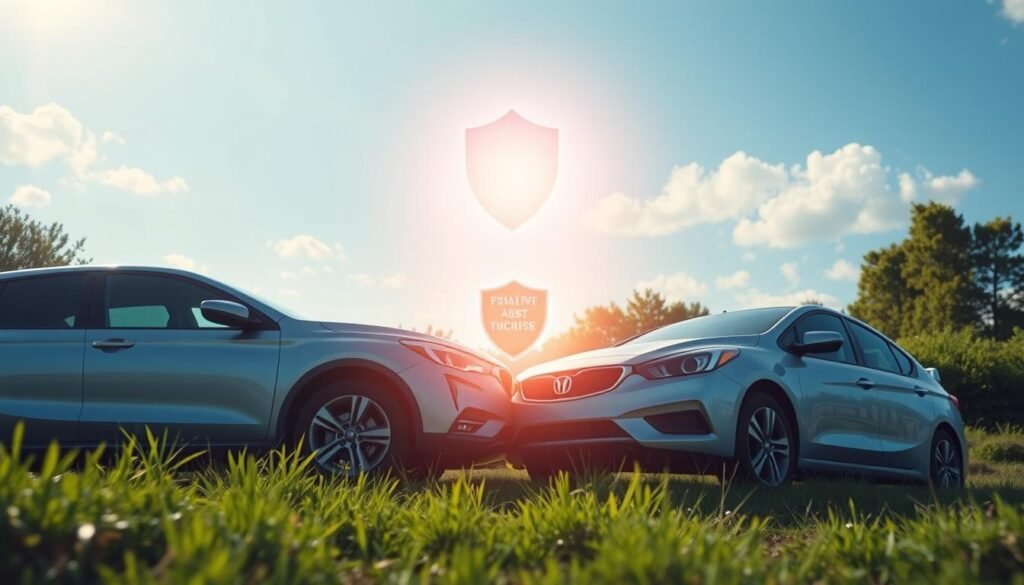Having the right car insurance is key to protecting yourself, your vehicle, and your wallet. In this article, I’ll help you navigate the world of car insurance. We’ll cover why coverage matters, the different types of policies, how to compare providers, and ways to cut down on premiums.
This guide is for all drivers, new or experienced. It’s packed with insights and tips to help you find the best car insurance for your needs. By the end, you’ll understand car insurance better and be ready to make smart choices for your peace of mind and financial security.
Key Takeaways
- Understand the importance of car insurance and why it is a necessity
- Explore the different types of car insurance coverage available
- Learn about the factors that affect car insurance rates
- Discover how to compare car insurance providers and find the best coverage
- Uncover strategies to save money on your car insurance premiums
Understanding the Importance of Car Insurance
Car insurance is more than a legal must. It’s a key financial shield in today’s unpredictable roads. Many see it as a cost, but knowing its value helps you make smart choices and keep your finances safe.
Why Car Insurance is a Necessity
In most states, you must have car insurance. But it’s more than a law. It protects you in accidents or other covered events. It covers repair costs, medical bills, and liability for damages or injuries to others. Without it, you could face huge costs that harm your finances.
Common Misconceptions About Car Insurance
- Car insurance is too expensive. Premiums vary, but affordable options exist. Look for discounts and bundle policies to save.
- I don’t need car insurance if I’m a safe driver. Even safe drivers can get into accidents. Insurance is key for protection.
- My car is old, so I don’t need comprehensive coverage. Even older cars need comprehensive and collision coverage. They protect against theft, vandalism, and damage.
Knowing the real value of car insurance and clearing up myths helps you make better choices. The right coverage is a small price for peace of mind and financial safety.
| Myth | Reality |
|---|---|
| Car insurance is too expensive | There are many ways to find affordable coverage |
| I don’t need car insurance if I’m a safe driver | Even safe drivers can be involved in accidents |
| My old car doesn’t need comprehensive coverage | Older vehicles may still require comprehensive and collision coverage |
Types of Car Insurance Coverage
Understanding car insurance types is key. Policies can be complex, but knowing the basics helps you make smart choices. This ensures you have the right protection for your needs.
Liability coverage is crucial. It protects you if you’re at fault in an accident. It covers the other driver’s medical costs and vehicle repairs.
Collision coverage fixes your car if you crash into something. Comprehensive coverage covers damage from theft, vandalism, or natural disasters.
Personal injury protection (PIP) pays for your medical bills and lost wages if you’re hurt in an accident. Uninsured/underinsured motorist coverage helps if the other driver has little or no insurance.
Knowing about these coverages lets you customize your policy. This way, you’re ready for any unexpected road incidents.
Factors Affecting Car Insurance Rates
Car insurance rates can change a lot based on different factors. As a driver, knowing what affects your rates is key. This knowledge can help you lower your premiums and get a better deal.
Driver’s Age and Experience
Your age and driving experience are big factors in insurance rates. Younger and less experienced drivers usually pay more. But, as you get more experience, your rates go down, showing you’re a safer driver.
Vehicle Make, Model, and Year
The car you drive also affects your insurance rates. The make, model, and year of your vehicle matter. Cars with good safety ratings and lower repair costs cost less to insure. But, fancy or high-performance cars might cost more.
Understanding what affects car insurance rates helps you make better choices. This way, you can find the car insurance that fits your budget and needs.
“Knowing the factors that affect your car insurance rates can empower you to make more informed choices and potentially save money on your coverage.”
Comparing Car Insurance Providers
Finding the right car insurance can be tough. It’s important to look beyond just the cost. Customer reviews and ratings offer insights into service quality and satisfaction.
Evaluating Customer Reviews and Ratings
Car insurance provider reviews offer real-life experiences. Look for common themes in feedback, such as:
- Responsiveness and professionalism of customer service representatives
- Timeliness and fairness of claims processing
- Clarity of policy details and coverage explanations
- Overall satisfaction with the provider’s performance
Also, check ratings from trusted sources like the J.D. Power Customer Satisfaction Survey and the Better Business Bureau. These ratings highlight top car insurance companies known for excellent service.
| Car Insurance Provider | Customer Satisfaction Rating (J.D. Power) | BBB Rating |
|---|---|---|
| GEICO | 4 out of 5 | A+ |
| State Farm | 3 out of 5 | A+ |
| Progressive | 4 out of 5 | A+ |
| Allstate | 3 out of 5 | A- |
By researching and comparing car insurance providers, you can make a smart choice. Find the coverage that suits your needs and budget.
Car Insurance for High-Risk Drivers
If you’re seen as a high-risk driver, finding affordable car insurance can be tough. But, there are ways to get the coverage you need.
High-risk drivers usually pay more for insurance. Knowing why you’re considered high-risk can help you find better deals. Let’s look at some ways to get car insurance as a high-risk driver.
Understanding High-Risk Driver Status
Insurance companies call drivers high-risk for several reasons:
- Accidents or traffic violations in the last few years
- Driving under the influence (DUI) or while intoxicated (DWI)
- Young drivers with little experience
- Drivers with poor credit scores
- Drivers with medical conditions that might affect driving
Being a high-risk driver doesn’t mean you’re a bad driver. It just means you might file more claims. So, insurance companies charge you more to cover this risk.
Finding Affordable Coverage
Even as a high-risk driver, you can find cheaper car insurance:
- Shop around: Compare quotes from different insurance companies to find the best rates.
- Consider a specialty insurer: Some companies offer coverage for high-risk drivers at better rates.
- Improve your driving record: A clean record can lower your rates and maybe even switch to standard insurance.
- Explore discounts: Look for discounts like safe driving programs, anti-theft devices, or bundling policies.
Being a high-risk driver doesn’t mean you have to pay too much for insurance. With some research and effort, you can find affordable coverage.
The important thing is to stay informed, compare options, and work on improving your driving record. With the right strategy, you can get car insurance that’s both affordable and protective.
Saving Money on Car Insurance
There are many ways to cut down on car insurance costs. You can use discounts and bundle policies to save a lot. This way, you can keep more money in your wallet.
Bundling Policies and Discounts
One smart move is to bundle your policies with the same company. Many insurers give discounts for insuring more than one vehicle. They also offer deals for combining car insurance with other types, like homeowners or renters.
By doing this, you get the ease of paying in one go. Plus, you could save a lot of money.
Insurance companies also have various discounts. These can be for safe driving, having certain car features, or even your job. Always ask about discounts you might qualify for to get the best rate.
| Discount Type | Potential Savings |
|---|---|
| Good Driver Discount | Up to 20% |
| Defensive Driving Course | 5-15% |
| Vehicle Safety Features | 10-15% |
| Bundling Policies | 10-25% |
By using these savings tips, you can make sure your car insurance costs are low. You won’t have to give up on the coverage you need.

Car Insurance: A Comprehensive Guide
Understanding car insurance can seem overwhelming. But this guide aims to help you make smart choices about your coverage. It’s important for protecting yourself, your car, and your money.
We’ll cover the basics of car insurance, including types of coverage and how rates are set. By the end, you’ll know how to pick the best policy for you. This will help you make choices that fit your driving style, budget, and preferences.
First, let’s look at the main types of car insurance:
- Liability Coverage – This coverage helps if you’re at fault in an accident. It pays for damages and injuries to others.
- Collision Coverage – It covers repairs or a new car if you crash into something.
- Comprehensive Coverage – This protects your car from theft, vandalism, and natural disasters.
- Uninsured/Underinsured Motorist Coverage – It helps if you’re hit by someone with little or no insurance.
Knowing these basics is key to picking the right policy. Think about your driving history, car value, and how much risk you’re willing to take. This will help you choose the right coverage levels for you.
Car insurance isn’t the same for everyone. By understanding the different options and comparing providers, you can find a policy that’s both affordable and protective. Stay with us as we explore more ways to save money and get the coverage you need.
Filing a Car Insurance Claim
Understanding how to file a claim for car insurance is key. Whether it’s an accident or damage to your vehicle, the process can seem tough. But with the right steps, you can make it smooth and quick.
Documenting the Incident
The first thing to do is document the incident well. You’ll need to collect:
- Date, time, and location of the incident
- Detailed description of the damage or circumstances
- Photographs of the damaged vehicle, if possible
- Police report, if applicable
- Contact information for any other parties involved
This documentation supports your claim and makes the process easier. It ensures your insurance has all the info they need.
Initiating the Claim Process
After you have your documentation, start the claim process with your insurance. Call your insurer’s claims department and share the incident details. Be ready to answer their questions and follow their paperwork instructions.
For a successful car insurance claim, stay organized, clear, and quick to respond. By following the right steps, your claim will be handled well, and you’ll get the coverage you need.

Car Insurance for Teenage Drivers
Getting car insurance for teenage drivers can be tough. As a parent, you want to protect your young driver but also keep costs down. We’ll look at special considerations and ways to get the right insurance for your teen.
Coverage Options for Teenage Drivers
There are several insurance options for teenage drivers. Liability coverage is essential, as it covers you if your teen is at fault in an accident. Collision and comprehensive coverage are also good, as they help pay for repairs or a new car if it’s stolen.
- Liability coverage: Protects you in the event of an accident where your teen is found at fault.
- Collision and comprehensive coverage: Helps cover the cost of repairs or replacement if your teen’s vehicle is damaged or stolen.
Strategies for Keeping Costs Down
Insuring a teenage driver can be expensive. But, there are ways to make it more affordable. Encouraging your teen to keep good grades and enrolling them in a defensive driving course can lead to discounts. Also, considering a higher deductible can lower your monthly payment.
- Maintain good grades: Many insurance providers offer discounts for teenage drivers with good academic performance.
- Enroll in a defensive driving course: Completing an approved defensive driving course can demonstrate your teen’s commitment to safe driving and potentially lead to lower rates.
- Consider a higher deductible: Opting for a higher deductible can help lower your monthly premium, but make sure your teen understands the financial responsibility.
Keeping your teenage driver safe on the road is crucial. With the right insurance and strategies, you can protect them without spending too much.
Car Insurance for Rideshare Drivers
As a rideshare driver, you face unique risks on the road. You need specialized car insurance coverage. It’s crucial to understand the potential pitfalls and ensure you have the right protection in place.
Understanding the Risks and Requirements
Rideshare driving comes with a higher level of exposure to accidents and liability. Your personal car insurance policy may not provide adequate coverage when you’re transporting passengers for hire. To mitigate these risks, rideshare companies typically require their drivers to maintain specific levels of car insurance, including:
- Liability coverage: This covers damages and injuries to other drivers if you’re at fault in an accident.
- Collision and comprehensive coverage: These protect your vehicle in the event of an accident or other damage.
- Uninsured/underinsured motorist coverage: This coverage kicks in if you’re hit by a driver with insufficient or no insurance.
It’s essential to review your rideshare company’s insurance requirements. Ensure your personal policy meets or exceeds these standards. Failing to do so could leave you financially vulnerable in the event of an incident.

Navigating the complexities of car insurance for rideshare drivers can be daunting. But with the right information and coverage, you can protect yourself and your passengers. By understanding the risks and requirements, you can make informed decisions to ensure you’re properly insured for the unique demands of your rideshare driving career.
Car Insurance and Your Credit Score
Your credit score is key when it comes to car insurance costs. Insurance companies use your credit score to figure out how much risk you are. A good score can mean lower insurance rates, while a bad score might mean higher rates.
Insurance companies think there’s a link between your credit and how likely you are to make a claim. People with better credit tend to make fewer claims. So, they get better rates from insurance companies.
To keep your credit score up and lower your insurance costs, be financially responsible. Pay bills on time, keep credit card balances low, and check your credit report often. Knowing how car insurance and credit score are connected can help you save money.
Strategies to Maintain a Good Credit Score
- Pay all bills on time, including credit card payments and loans.
- Keep credit card balances low, aiming for a utilization rate of 30% or less.
- Check your credit report regularly and dispute any errors or inaccuracies.
- Avoid opening new credit accounts unnecessarily, as this can lower your credit score.
- Maintain a mix of different types of credit, such as credit cards, loans, and mortgages.
By managing your credit score well, you can save on car insurance and have better coverage.
Car Insurance and Accident Forgiveness
Accidents can worry car owners, leading to higher insurance costs. But, there’s a coverage that helps – accident forgiveness. It stops your rates from going up after your first accident, keeping your insurance affordable.
Accident forgiveness is a great add-on to your insurance. It gives you peace of mind and keeps your finances stable after an accident. Knowing how it works and its benefits helps you protect yourself and your wallet.
How Accident Forgiveness Works
Accident forgiveness kicks in after you’ve driven safely for three to five years. Once it’s on, your rates won’t go up because of your first accident. This avoids the usual rate hike, keeping your car insurance costs down.
The Benefits of Accident Forgiveness
The main perk of accident forgiveness is the financial safety it offers. It stops your rates from rising after your first accident. This is a big plus for drivers who’ve been accident-free for a long time and don’t want a rate hike because of one mistake.
It also keeps your insurance history clean. This is key for keeping your rates low and getting good deals in the future. It shows insurers you’re a careful driver, even when accidents happen.
“Accident forgiveness is a game-changer for drivers who value the stability and affordability of their car insurance rates.”
To get accident forgiveness, ask about it when you’re looking for or renewing your car insurance policy. Many insurers offer it. It’s a smart choice for full car insurance protection.

| Feature | Benefit |
|---|---|
| Accident Forgiveness | Prevents rate increase after first at-fault accident |
| Maintains Insurance History | Demonstrates responsible driving, even with occasional mistakes |
| Financial Protection | Avoids significant spike in insurance premiums |
Conclusion
As we wrap up our look at car insurance, it’s clear that the right coverage is key. We’ve covered why car insurance matters, the different types of coverage, and what affects your rates. Knowing these helps you make smart choices and stay safe on the road.
Car insurance is more than just a law. It’s a shield against the unexpected. By comparing options, using discounts, and choosing the right coverage for you, you can find the best deal. This advice is for everyone, from new drivers to those looking to save money.
Now, it’s time to check your current insurance and see what else is out there. Taking these steps will give you peace of mind. You’ll know you’re ready for anything that comes your way while driving. Let’s keep making smart choices to stay safe on our roads.



